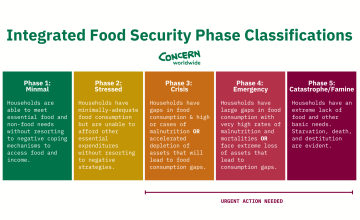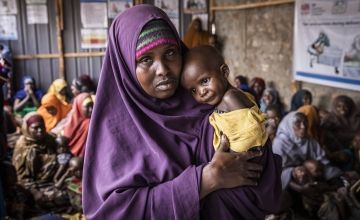
Knowledge Hub
Right now, millions of people are living in near-famine or famine-like conditions around the world.
“Famine” is a word that gets used a lot in humanitarian contexts, but it has some pretty specific meanings. Here, we go into what a famine is, when it’s declared, how it’s measured, and the long-term impacts famine can have on individuals, communities, and countries.
What is a famine?
Famines take place when a substantial percentage of a country’s (or region’s) population are unable to get sufficient food. This lack of food and nutrition security leads to high levels of acute malnutrition and death.
How do we measure hunger?
There are many countries with alarming levels of hunger and chronic food insecurity. This is why the United Nations designed the Integrated Food Security Phase Classification (IPC). The IPC measures a country’s food insecurity on a five-phase scale, from minimal food insecurity to catastrophic or famine levels of hunger.

When is a famine declared?
Famine (Phase 5 on the IPC) represents the highest levels of hunger and malnutrition in a region. A famine is declared when:
- 20% of a population are suffering extreme food shortages
- 30% of children under the age of 5 are suffering acute malnutrition
- The death rate of an area has doubled, or two people (or four children) out of every 10,000 people die each day
Famine can be declared across a country or either local or international regions. However, it’s up to individual governments to declare the beginning (and end) of a famine. This can be especially difficult in many of the world’s hungriest countries: Generally, famines occur in areas where there is a lack of infrastructure, which can make these data points hard to know for certain.
What causes famine?
Many of the same causes of hunger also contribute to a famine. The World Food Programme points to five main causes of famine:
- High food prices
- Natural disasters
- Climate change
- Lack of humanitarian access
- Conflict
Looking at the above, you may notice that some of these causes are connected. These intersectionalities are one of the biggest reasons that a hunger crisis becomes a famine. In these situations, there is never an easy fix. The WFP also points out that the causes of famine (unlike some causes of hunger) are largely man-made, meaning that we can control the outcome. But this often requires international diplomacy, cooperation, and compromise.

What are the effects of famine?
Famine is more than just hunger. Its effects are further reaching, and last long after the famine is declared over.
The health impacts of famine
The World Health Organisation says: “Between starvation and death, there is nearly always disease.” Among the effects of hunger is a weakened immune system. Often, people who die during a famine don’t die from starvation, but from diseases that take advantage of their immune system’s vulnerability. These diseases can include cholera, malaria, measles, and tuberculosis.
The health effects of famine can also carry on for generations, especially as malnutrition affects maternal and child health. Recent research conducted at UC Berkeley’s School of Public Health in California shows another way that famine may impact health from one generation to the next:
“We have long known that exposure to nutritional stress and famine can lead to long-term health consequences including type 2 diabetes, schizophrenia, and hypertension, and that some of these effects may pass from generation to generation,” says lead researcher Qu Cheng, whose team focused on the intergenerational effects of the Great Chinese Famine (1959-61) and was the first to connect famine to intergenerational transmission of tuberculosis (TB). “We now know that more than 60 years later, this historic famine continues to exacerbate TB transmission as well, one of the world’s most intractable global infectious disease crises.”

Famine can have lifelong consequences for its youngest survivors
Anyone who survives a famine may be at risk of chronic physical and mental health issues, among other residual effects. However, children are not only among the most vulnerable to mortality during a famine, but to a lifetime of impacts afterwards.
One of the main side effects for children suffering malnutrition is stunting (low height for age). Occurring early on in their childhood, stunting impacts body and brain development, often leaving children open to chronic health issues as well as lower IQ levels. This can have a serious knock-on effect: Studies have shown that children who are stunted are four times more likely to die than their non-stunted peers. If they survive to adulthood, they’re more likely to be caught in the cycle of poverty, earning 22% less than their peers.
Famine is linked to conflict
Hunger and conflict go hand-in-hand. Not only is hunger one of the main reasons conflict breaks out, it’s also a means of continuing conflict once it erupts. There are instances of hunger being used as a weapon of war, and the more dire a food shortage is, the more desperate those living through it become. Tensions are exacerbated. Young men are more likely to join one side of the conflict in exchange for the promise of food and money. Women and girls are more vulnerable to harassment and violence.
How can we prevent famine?
Famine doesn’t happen overnight. With enough early warning and early action (EWEA), it can be prevented. We saw this happen in Somalia in 2017.
Traditional aid models, often by necessity, rely on certainty. But in emergency contexts, this doesn’t always work. As we saw with Somalia’s 2010-12 famine, waiting for the full picture of need and risk to develop wasted precious lead-time. Somalis paid the ultimate price. Breaking with tradition, we created an approach to emergencies called Early Warning, Early Action (EWEA). This “no regrets” strategy formed the foundation of our programme “Building Resilient Communities in Somalia” (BRCiS).
Instead of responding to an emergency based on certainty, we began responding (proportionately) to the probability of a disaster. In some cases, this meant that we responded early to the signs of a crisis that didn’t come to pass. But, in the long term, EWEA still saves money: An ounce of prevention is worth a pound of cure.

As early as 2016, there were signs that the rains Somalis depend on for agriculture and pastoralism would fail the following year, putting millions of lives at risk. BRCiS team members began responding with monthly cash transfers to the most vulnerable households in the region. That November, as subsequent rains appeared to be failing, thereby increasing the possibility of catastrophe, we increased the amount of those cash transfers by 30% and doubled the number of families receiving these funds. We increased transfers once again in January of 2017, doubling the amount we initially paid families.
The rains failed, and crops along with them. However, markets continued to function and food remained available for purchase. No famine was declared in Somalia that year.
Ending hunger and famine: Concern’s response
In many of the countries where we work, people rely on the food gained from their land to survive. Extreme weather events such as drought and flooding, and associated threats such as locust invasions, can decimate these crops and have a devastating impact on people's ability to feed their families.
Concern’s approach to environmental protection aims to conserve natural resources and, where possible, to repair damage and reverse trends. As well as meeting immediate needs such as food and livelihood support, we also work with farmers to help them adjust to climate change and build resilience for the future.
For almost 20 years, our Community Management of Acute Malnutrition (CMAM) approach to tackling acute malnutrition has been extremely effective, so much so that it has become the preferred approach for tackling malnutrition internationally.
The central principle of CMAM is to treat malnourished children in their homes. As a result, it reaches more children and reduces the risks and expenses in travel for carers, malnourished children and their siblings.
Children who have been admitted to our programme are provided with weekly medical treatment and given one week's supply of therapeutic food. This micronutrient-enriched food is the key to success.
Now, the CMAM Surge approach is based on the observation that in many contexts, the number of children seeking treatment for acute malnutrition peaks during certain months of the year.
These seasonal ‘surges’ in demand are driven by many overlapping factors, including, for example, the pre-harvest hunger gap, increased incidence of malaria or diarrhoea during the rainy season, women’s workload patterns and movements associated with grazing livestock.
Other ways to help
Donate now
Give a one-off, or a monthly, donation today.
Join an event
From mountain trekking to marathon running, join us for one of our many exciting outdoor events!
Buy a gift
With an extensive range of alternative gifts, we have something to suit everybody.
Leave a gift in your will
Leave the world a better place with a life-changing legacy.
Become a corporate supporter
We partner with a range of organisations that share our passion and the results have been fantastic.
Create your own fundraising event
Raise money for Concern by organising your own charity fundraising event.





